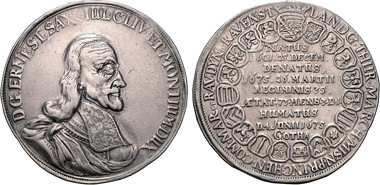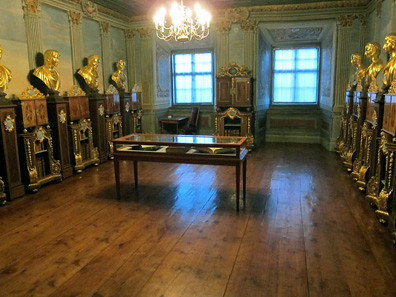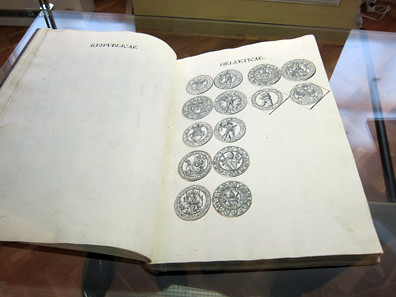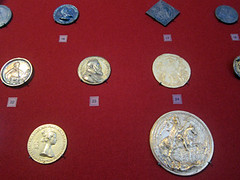
PREV ARTICLE
NEXT ARTICLE
FULL ISSUE
PREV FULL ISSUE
NUMISMATICS IN GOTHA
Ursula Kampmann published a great article on Numismatics in Gotha in the December 6, 2012 issue of CoinsWeekly. Here are some excerpts, but be sure to read the complete version on the web.
-Editor
Ernst, as nearly all of his nine brothers, served as a colonel to the Swedish army during the Thirty Years’ War. Thus he knew the horror of the battle field and how much the civilians feared plundering. No wonder he yearned for another time and called the castle erected in an inherited territory ‘Schloss Friedenstein’ (‘Palace of the peace rock’). It was, indeed, conceived as a gigantic palace typical of the early baroque. Splendour took the place of actual power of which, most probably, the small Duchy of Saxe-Gotha was lacking. Schloss Friedenstein was not only destined to live in. All institutions of the then new state were housed there, some rooms were intended for the administration of the country, other for the archives. The stables, the smithy and the arsenal made it clear that this place was the heart of the state’s military defence, too. A theatre which is still conserved, displayed the importance of the duke’s court to the artistic world.

Ernst I the Pious, 1640-1675. Reichstaler 1675 in occasion of his death. And, of course, the mint was placed as well in Schloss Friedenstein – at least for some years. It was located where you can find the restaurant today. The early coinage was definitely not economically relevant. These issues served as representative objects and displayed the duke as a pious man – the result is, indeed, that this is how he is still called today. The representative rooms were really impressive and all the time, we came across busts of rulers known to us from coins.

Coin Cabinet One of them is this: Frederick II of Saxe-Gotha, or of Saxe-Gotha-Altenburg as he was called since 1672. He was very fond of numismatics and, in 1692, he appointed Ernst Tentzel curator of the coin cabinet. Tentzel was a famous numismatist who published the ‘Saxonia Numismatica’ which is, even nowadays, still a reference work. In 1712 Frederick II scored an incredible coup: he purchased the collection of count Anton Günther II von Schwarzburg-Arnstadt (1653-1716). Ernst I (1601-1675) received a part of the Ernestine Cabinet of curiosities comprising, among other things, 516 coins and medals. It is really remarkable that this collection in Gotha exists, but particularly, how precisely we can describe all details of how it came to existence thanks to the sources at our disposition! 781 pieces were purchased between 1653 and 1656.

The son of Ernst I, Frederick I (1646-1691), was a passionate collector, too. He considered himself to be a baroque aristocrat, and he attempted to conceal his loss of power – provoked especially by the division of his father’s estate – by increasing his representation. Part of this conception of oneself was a coin collection. The duke enjoyed making an inventory of his coins and arranging them in order, as we learn from his diaries. Frederick I passed on this pleasure in numismatics to his son Frederick II (1676-1732). In 1712, Frederick II succeeded in acquiring the collection of Anton Günther II, ruler of Schwarzburg, a collection that was known all over Europe. The latter had gathered this impressive collection with the help of the Parisian numismatist Andreas Morell (1646-1703). The heirs of Frederick II kept purchasing material. However, it would be too long a list if we tried to enumerate all acquisitions. Those interested in this topic should read the brand-new book ‘Gothas Gold’ where Martin Eberle describes the history of the collection in all details. To read the complete article, see: Numismatics in Gotha (www.coinsweekly.com/en/News/4?&id=1644)

Wayne Homren, Editor The Numismatic Bibliomania Society is a non-profit organization promoting numismatic literature. See our web site at coinbooks.org. To submit items for publication in The E-Sylum, write to the Editor at this address: whomren@gmail.com To subscribe go to: https://my.binhost.com/lists/listinfo/esylum All Rights Reserved. NBS Home Page Contact the NBS webmaster 
|
